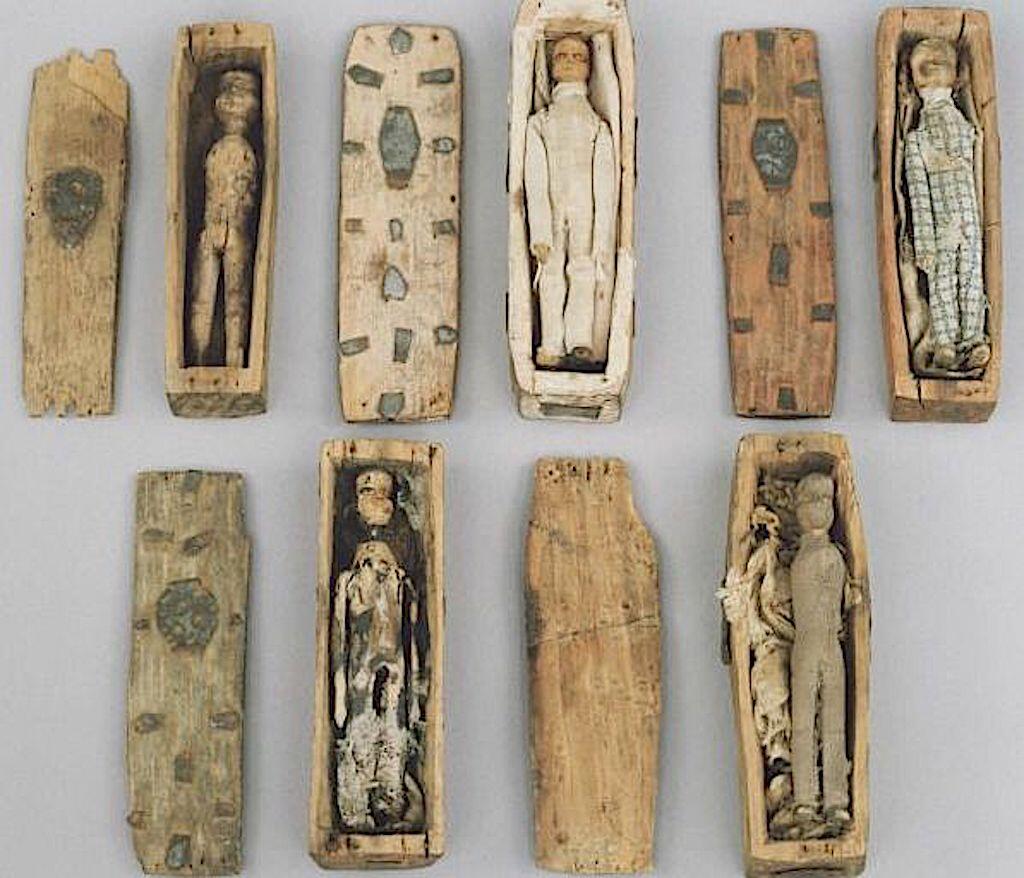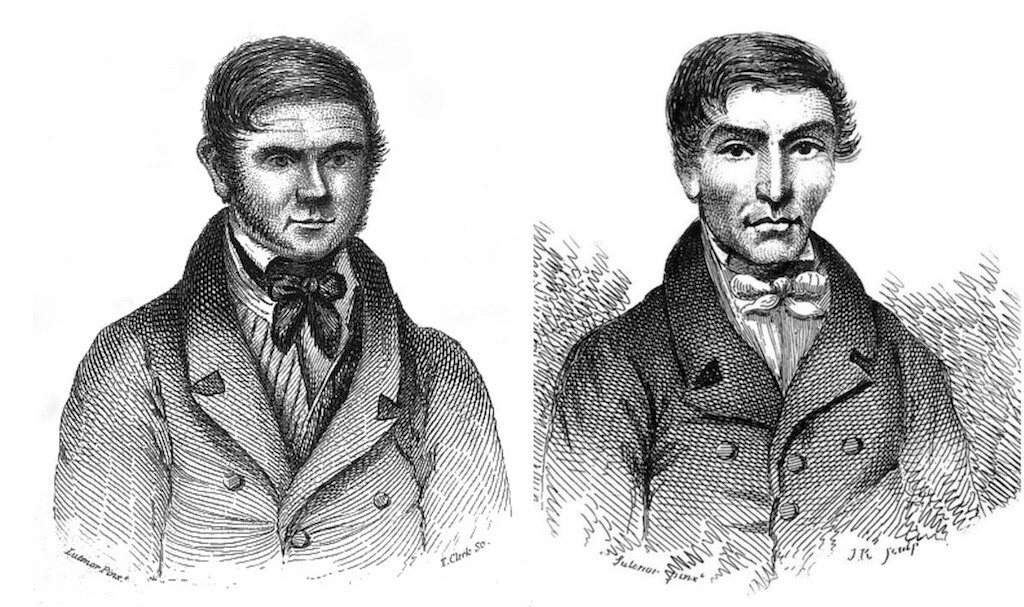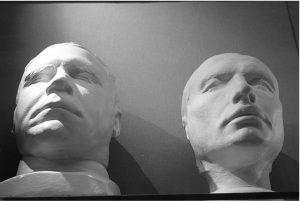In 1836, three boys were out hunting for rabbit holes and found a puzzling group of 17 dolls in a small niche near the rocky structure called Arthur’s Seat at Holyrood Park. Oddly, each doll lay securely in its own coffin. Later, people named them the Burke and Hare Murder Dolls because they assumed the strange figurines were related to the 17 murder victims of William Burke and William Hare in Edinburgh, Scotland, during the late 1820s. However, whether or not this was true, and who made the dolls and hid them in the nook, or why, is still a mystery.

This image from the National Museum of Scotland shows five of eight figurines and their coffins with intricate metal details.
Discovery of the Burke and Hare Murder Dolls
As the boys looked for rabbit burrows, they spotted a strange opening about one foot wide and one foot deep in the rocky hillside. A few pieces of slate stones were stuffed into the opening and protected the coffins from the weather.
Initially, the Burke and Hare Murder Dolls, also known as the “Lilliputian coffins” and the “Fairy Coffins”, didn’t appear to be anything special. Even the children who found them did not realize their value. The youngsters supposedly pitched the dolls at one another and destroyed about half of them. Only eight unopened coffins made it down from the hillside, which sat about 820 feet high overlooking the city of Edinburgh.

Arthur’s Seat, where three boys purportedly found 17 figurines interred in coffins. CC3.0 David Monniaux
Descriptions of the Dolls and Coffins
The number of dolls appeared to represent the bodies sold to Dr. Knox (including the one that died of natural causes). Dating of the fabrics used for the burial cloths and the threads places their origins around the same time as the murders. However, whoever made the dolls and stashed them may have done so numerous times between 1800 and 1830. According to author Charles Fort, someone had placed the dolls and their coffins one-by-one in the cave in three levels. The bottom level of eight had the most decomposition in the coffins and their contents. The next level up, consisting of another row of eight dolls, was in slightly better shape. There was only one doll on the upper level. This one seemed the newest and lead many people to believe that more dolls would have followed in that row at some future time.
Related: Burke and Hare: Murderous Merchants in the Fresh Cadaver Market
Most people assume the varying degrees of decomposition reflect different times of placement. However, it is possible that some dolls may have been more exposed to weathering than others. Analysis of the figurines indicates that they probably started out as toys or something other than corpses. None of the figures had closed eyes, and they all had black feet as if they were wearing boots. One figure had its arms removed before it could be fit into its coffin. Apparently, someone then repurposed the figures into corpses after building the coffins.
Report in the Scotsman
According to Mike Dash from Smithsonian, the Scotsman newspaper reported that each coffin:
“contained a miniature figure of the human form cut out in wood, the faces in particular being pretty well executed. They were dressed from head to foot in cotton clothes, and decently laid out with a mimic representation of all the funereal trappings which usually form the last habiliments of the dead. The coffins are about three or four inches in length, regularly shaped, and cut out from a single piece of wood, with the exception of the lids, which are nailed down with wire sprigs or common brass pins. The lid and sides of each are profusely studded with ornaments, formed with small pieces of tin, and inserted in the wood with great care and regularity.”
The coffins were made from Scots pine. There are some inconsistencies about their construction. Therefore, experts believe two different people may have created them. The maker carved out one solid piece of wood for the coffin and then placed another piece on top for the lid.
Brief Story of Burke and Hare
As their name suggests, the Burke and Hare Murder Dolls are related to the sinister deeds of two men: William Burke and William Hare. Both were Irishmen who met in Scotland and became close friends in the 1820s. Hare ran a boarding house with his wife. There, one of the tenants died of natural causes. Burke and Hare sold the body of the man to a doctor at Edinburgh University for use as a medical school cadaver.

William Burke (L) and William Hare (R), as they appeared in court. George Andrew Lutenor, c. 1829.
At the time, the medical schools had a shortage of bodies to use for dissection. They were only allowed to use executed criminals. The problem was, however, that criminals were facing execution less frequently. To supplement their needs, anatomists began purchasing corpses from body snatchers.
Dr. Knox, of the University of Edinburgh, relied on Burke and Hare to furnish his anatomy school with plenty of fresh cadavers. After they sold the deceased tenant’s body for 7 pounds — a significant amount in those days — Burke and Hare realized that they could make a sizeable living in corpses. Future fresh corpses went for 10 pounds.
After 17 victims, police caught the duo, and Hare made a deal to turn King’s evidence in exchange for his freedom. He testified against Burke, who died by execution, and in a morbid twist of fate, the judge sentenced him to public dissection. Anatomists saved several of his body parts, including a death mask of his face. Hare walked. No one knows what happened to him.

Burke’s death mask and Hare’s life mask. Anatomical Museum of Edinburgh University. (Stephencdickson/CC BY-SA 4.0)
Theories About the Murder Dolls
One theory is that one of the murderers may have felt such guilt about the victims who never got a proper funeral, that he made coffins and gave the victims a symbolic burial. Others theorize that they represent sailors lost at sea or that Celtic magic or Voodoo rituals were their true purpose.
If someone made the Burke and Hare Murder Dolls before the murders became public knowledge, only a handful of people could have carved them. There was Dr. Knox, who likely knew the corpses he was purchasing were murder victims. There were Burke and Hare, Hare’s wife, and Burke’s wife. Dr. Knox’s brother possibly knew as well. One of these people could have made the dolls out of guilt or for religious reasons. Alternatively, one of the killers could have made them as souvenirs and stashed them in the cave. Theoretically, Hare could have made them after Burke’s murder trial and put them there as well. However, he fled town rather quickly to avoid the angry public.
Some theorists suggest that Burke couldn’t have made the dolls since there are 17, and he would not have had the time after police found their last victim. The arrest happened too quickly for him to stash the last doll. However, it is possible that Burke and Hare actually had an additional victim. If this is the case, he may have stashed the last figurine before police stopped them. People who knew Burke claimed that he was a very religious man. Although scientists collected DNA from Burke’s body, they were unable to acquire DNA from the dolls and look for a match.
The main issue with the theory that the dolls resulted from the Burke and Hare murders, also called the West Port Murders, is that at least 12 of their victims were women. The figurines are clearly all-male wearing men’s burial attire. (Emery 2014).
If someone placed them in the niche to give a group of people a proper burial, was it due to some disaster in which people perished? Author Jeff Nisbet believes they resulted from the populist uprising Radical War of 1820. Rather than the Burke and Hare Murder Dolls, he calls them the Arthur’s Seat Coffins. He states:
Authenticity of the Dolls
Many people have accepted that the figurines and their coffins are genuine. However, there are those who believe they are a hoax. None of the children gave any first-hand testimony about them. What happened to the other nine dolls? When the boys realized that people seemed interested in the wooden objects, wouldn’t they have gone back to find the “remains” of the other figurines up on the hillside? Not knowing the truth adds one more dimension to the mystery.
According to Smithsonian, the boys’ schoolmaster acquired the set. He then took it to his archaeological society, and the set amazed the group. Oddly, it wound up under the ownership of a jeweler, who displayed the objects in his personal museum until he retired and sold the set at auction for 4 pounds around 1845. Private collectors maintained the Burke and Hare Murder Dolls for the remainder of the century. In 1901, Christina Couper donated the entire set of eight to the National Museum of Scotland in Edinburgh. But the mystery of Edinburgh’s coffin dolls endures.